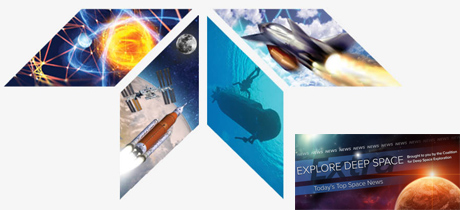In Today’s Deep Space Extra… The Coalition for Deep Space Exploration is happy to welcome Teledyne Brown Engineering as a member of our organization! The Artemis I Space Launch System and Orion capsule are set to roll to the launch pad next week. MDA will build the Gateway’s Canadarm3.
Human Space Exploration
SLS prepares for rollout and WDR as three additional SLS rockets wait in the wings
Coalition Member in the News – Boeing
NASAspaceflight.com (3/10): The Space Launch System (SLS) and Orion spacecraft for NASA’s Artemis I test flight are slated to roll out to Launch Pad 39B at NASA’s Kennedy Space Center (KSC) next Thursday in preparation for a Wet Dress Rehearsal (WDR), a launch countdown simulation, planned to start April 3. Upon completion, the integrated rocket and crew capsule will roll back to KSC’s Vehicle Assembly Building (VAB), the rehearsal will be assessed, and a launch date will be decided for the Artemis I mission. Meanwhile, three more SLS rockets are being assembled at NASA’s Michoud Assembly Facility for crewed Artemis missions that are to follow.
Astrolab unveils Artemis lunar rover design
Coalition Members in the News – Lockheed Martin, Northrop Grumman
SpaceNews.com (3/11): Astrolab, a California startup, has tested the prototype for a lunar rover intended for possible use by NASA’s Artemis mission astronauts. The Flexible Logistics and Exploration (FLEX) rover can accommodate 1,500 kilograms, or about 937 pounds of cargo, while steered by two astronauts or remotely commanded. FLEX was recently tested in Death Valley, California.
This arm has brains: Here’s what Canadarm3 – the latest version of the robotic space arm – will be able to do
Toronto Star (3/10): MDA (formerly MacDonald, Dettwiler and Associates Ltd.), of Canada, will develop and assemble a third robotic arm for space under a $269 million agreement, the Canadian Space Agency (CSA) announced. The new robotic arm destined for NASA’s lunar orbiting Gateway will leverage the past experience for the development and operation of robotic arms aboard NASA’s space shuttle and currently the International Space Station (ISS). Autonomous operations of the Gateway robotic arm are anticipated. NASA is looking to 2024 for the launch of the first Gateway elements. The robotic arm could follow in 2027.
Exclusive: China looks to have foreign astronauts on board its space station some day
News.cgtn.com (3/10): Once fully assembled and operating stably, China’s space station will welcome astronauts from foreign countries, according to Zhou Jianping, the chief designer of China’s human spaceflight program. The station currently consists of a core module and robotic arm. Two crews, or a total of six astronauts, have staffed the station so far. Six missions are planned this year to complete the assembly, including the addition of two laboratory modules.
Other News
Chinese official calls for protection of space assets, international coordination mechanisms
SpaceNews.com (3/10): Yang Mengfei of the China Academy of Space Technology (CAST) told China National Radio that there is a need to accelerate the development of space asset protection policies and related international coordination mechanisms. Regarding Mengfei’s comments, Victoria Samson, Washington Office director at the Secure World Foundation, said that it’s also important to be as transparent as possible so that there isn’t inadvertent escalation or perceptions that space capabilities are intended to be offensive.
Soyuz embargo strands satellites with limited launch options
SpaceNews.com (3/10): The Soyuz rocket’s sudden exit from the global stage has left more than a dozen non-Russian satellite missions without clear paths to orbit. According to experts, prompt rescheduling will be challenging as customers have existing backlogs. The European Union counted on at least six Soyuz rockets this year and beyond to launch a mix of navigation, Earth observation, and science satellites from France’s South American spaceport. Smaller rideshare customers from Japan to Sweden say they may need new accommodations, and a South Korean imaging satellite is at Russia’s Baikonur Cosmodrome awaiting a launch that’s now in question.
Congress keeps NOAA’s Office of Space Commerce in NESDIS
Spacepolicyonline.com (3/11): The 2022 omnibus appropriations bill that emerged from the House and Senate this week keeps the Office of Space Commerce within the NOAA organization that manages weather satellite activities rather than moving to a higher administrative authority. In 2018, NOAA was designated to take over responsibilities from the Department of Defense (DoD) for civil and commercial Space Situational Awareness. The omnibus provides the National Environmental Satellite, Data, and Information Service (NESDIS), which operates the nation’s civil weather satellite systems, with $16 million, $6 million more than requested by the White House.

